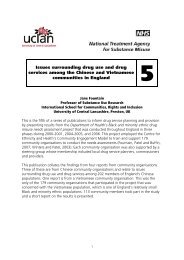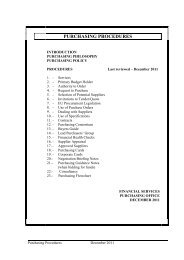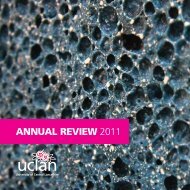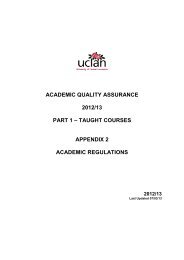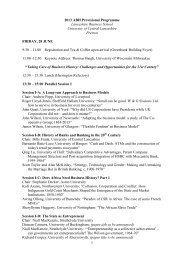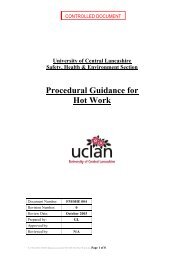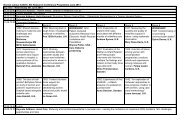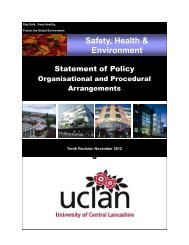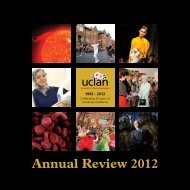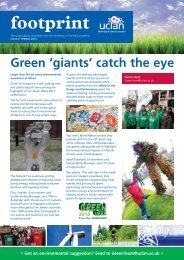Autumn 2011 Issue - University of Central Lancashire
Autumn 2011 Issue - University of Central Lancashire
Autumn 2011 Issue - University of Central Lancashire
You also want an ePaper? Increase the reach of your titles
YUMPU automatically turns print PDFs into web optimized ePapers that Google loves.
26 Conference Reviews<br />
Pr<strong>of</strong>essors in Pr<strong>of</strong>ile:<br />
Learning to Build or Building to Learn?<br />
An Interview With Jack Goulding<br />
School <strong>of</strong> Built and Natural Environment<br />
Jack Goulding is Pr<strong>of</strong>essor <strong>of</strong> Construction<br />
Project Management in the School <strong>of</strong> Built<br />
and Natural Environment and Director <strong>of</strong><br />
the Centre for Sustainable Development at<br />
UCLan. He is a Charted Construction<br />
Manager and sits on several industry panels.<br />
Jack has worked on numerous national and<br />
international projects in the areas <strong>of</strong> ICT,<br />
Virtual Reality, Strategic Planning,<br />
Organisational Learning, and Open<br />
Manufacturing. He has also developed<br />
several undergraduate and postgraduate<br />
ICT/construction-related programmes, and<br />
helped many construction organisations<br />
with their research and development and<br />
training initiatives.<br />
Following Jack’s Inaugural Pr<strong>of</strong>essorial<br />
Lecture, which provided an insight into the<br />
myriad <strong>of</strong> challenges facing construction<br />
pr<strong>of</strong>essionals and explored issues from a<br />
multi-dimensional learning stakeholder<br />
perspective, Mike Holmes and Emma<br />
Hesketh joined Jack in his <strong>of</strong>fice in Harris<br />
Building to find out more.<br />
><br />
Could you just give us an outline <strong>of</strong> your<br />
research area?<br />
My research area covers a wide range <strong>of</strong><br />
construction-related issues. Chronologically,<br />
my focus has always been to look at<br />
developing a strategic focus for construction<br />
organisations, particularly with respect to<br />
business trajectories and core business<br />
operations. That led me to be involved in<br />
training and development; and more<br />
recently through some <strong>of</strong> my research<br />
projects, I have been involved in virtual reality<br />
simulation and immersive environments.<br />
Having just finished a major EU research<br />
project that involved 23 partners; part <strong>of</strong> my<br />
deliverable was to develop a construction<br />
site training simulator for <strong>of</strong>f-site<br />
manufacturing. This opened up a lot <strong>of</strong><br />
avenues with both industry and academia,<br />
and is now starting to include such issues as<br />
learning styles, through to logistics<br />
management etc. This will help high level<br />
managers to appreciate the different<br />
concepts and techniques associated with <strong>of</strong>fsite<br />
manufacturing, in contrast to traditional<br />
methods <strong>of</strong> working in construction. Offsite<br />
manufacturing has been quite prevalent in<br />
places such as Japan, Sweden and the USA,<br />
but is a relatively new concept elsewhere.<br />
So, my research focus is still predominantly<br />
helping construction companies move their<br />
corporate strategies forward; and skill<br />
development [using a construction site<br />
simulator] is an important part <strong>of</strong> this.<br />
We are currently developing a<br />
Construction Site VR Simulator, in order<br />
to train construction pr<strong>of</strong>essionals in this<br />
new way <strong>of</strong> working and thinking.<br />
You have mentioned <strong>of</strong>f-site<br />
manufacturing. Is that where a complete<br />
unit, e.g. a bathroom, is manufactured<br />
<strong>of</strong>f site, shipped in, and placed in the<br />
building?<br />
Absolutely, but things have moved on a little.<br />
Part <strong>of</strong> supply chain management is that we<br />
now have the capability <strong>of</strong> being able to use<br />
what are called “smart objects” or<br />
“intelligent components”. These form part<br />
<strong>of</strong> product catalogues, which are basically<br />
databases <strong>of</strong> objects. These are able to store<br />
knowledge and intelligence; for example,<br />
behavioural aspects, design characteristics,<br />
life cycle requirements etc. They can also be<br />
integrated into Building Information<br />
Modelling (BIM) systems. From this, you can<br />
select an appropriate ‘object’ to see how it<br />
will perform in a particular environment.<br />
You are also able to see which<br />
manufacturers are available, the time taken<br />
to make, deliver etc. This could be for<br />
example a simple bathroom unit, through to<br />
a complete bathroom, or a full house for<br />
that matter. The only constraint really is on<br />
size. Logistics are important here. If it can fit<br />
within a container, then we can generally<br />
have this manufactured <strong>of</strong>f-site and bring it<br />
directly to site for assembly. This approach<br />
has many benefits, not least improvements<br />
in quality, faster erection times, less wet<br />
trades, reduced waste, improvements in<br />
Health and Safety etc. So, put simply, almost<br />
a “plug and fit” approach. This method<br />
takes away many <strong>of</strong> the traditional on-site<br />
activities, and replicates these in a controlled<br />
environment (the factory), which also has<br />
the additional benefit <strong>of</strong> not being affected<br />
by weather conditions etc. However, there is<br />
a cultural mind set change that is needed<br />
within the industry. People are still a little bit<br />
wary <strong>of</strong> this new approach as opposed to<br />
the traditional brick-block, concrete or steel<br />
frame construction that we are traditionally<br />
used to. This is predominantly a culture<br />
issue, which is slightly different in other<br />
countries. So, this is one <strong>of</strong> the things that<br />
we need to deal with, as it has a knock-on<br />
effect on all parts <strong>of</strong> the business, including



